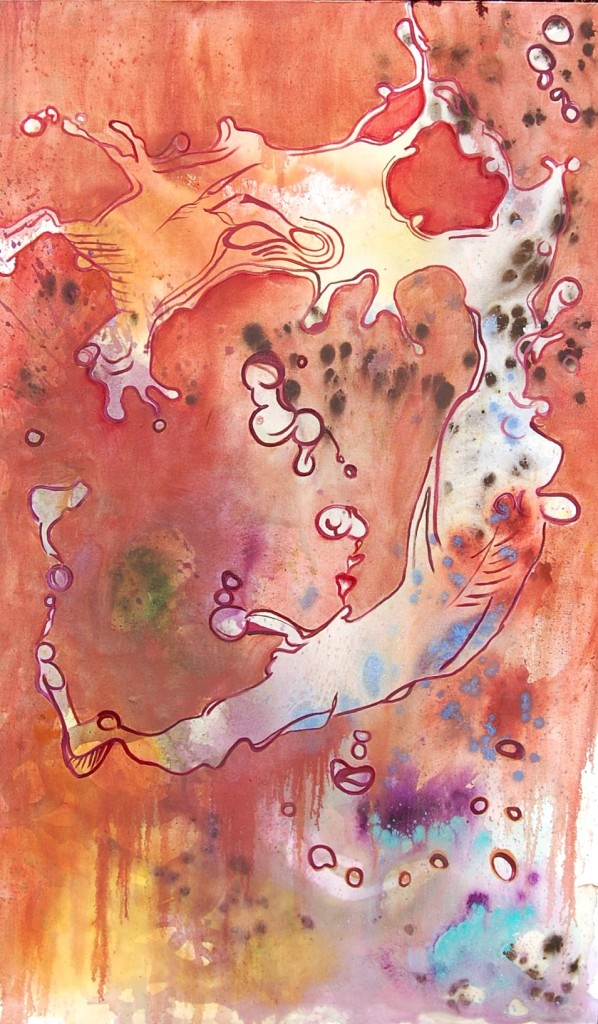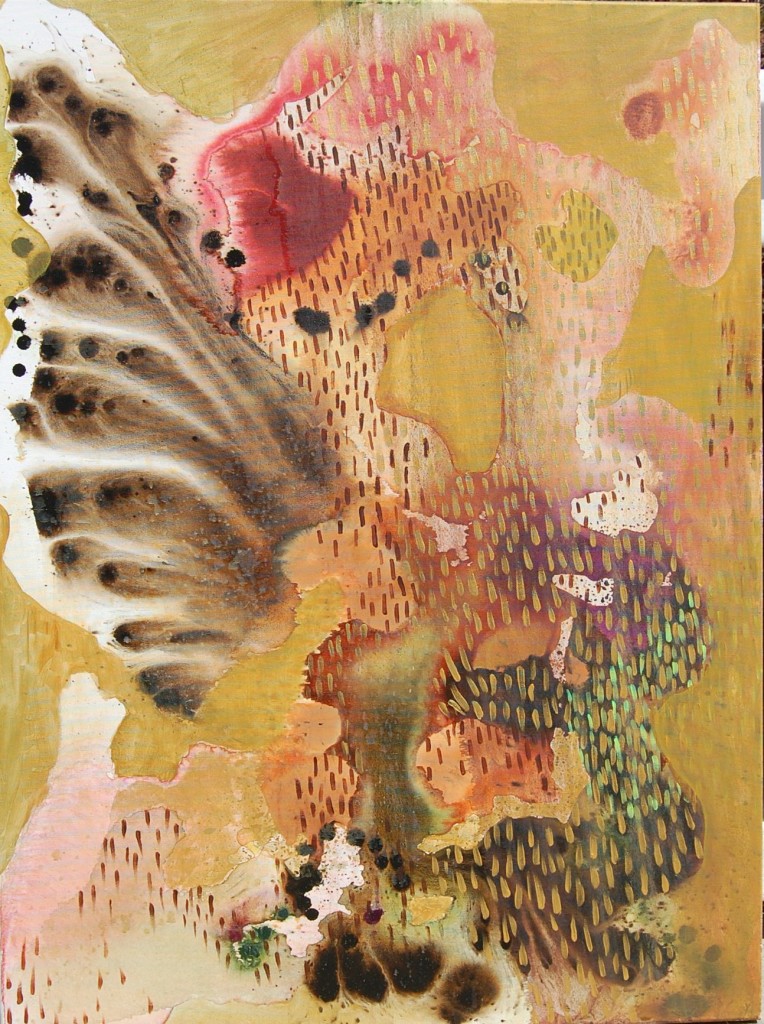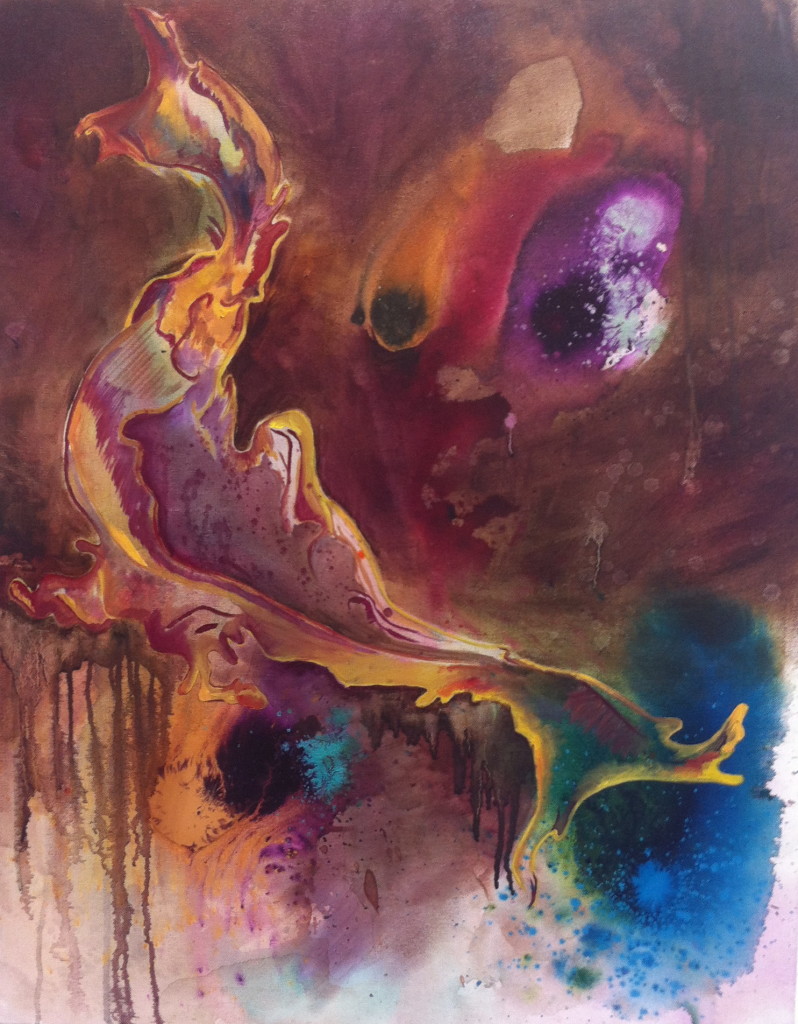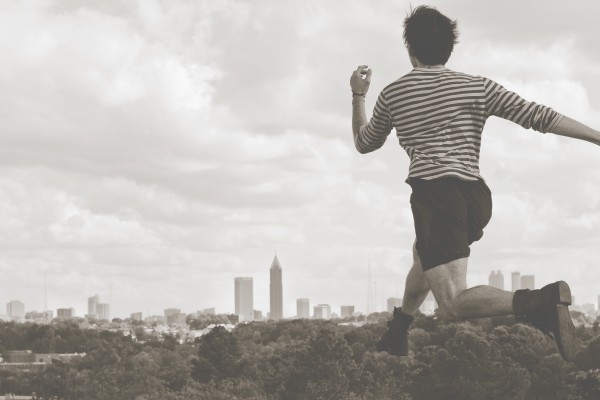 It’s not often we find local artists who aren’t Atlanta transplants, but artist Sydney Daniel is one of them. Born and raised in ATL, Daniel mixes water and pigment on large canvases, turning them into beautiful abstract forms. With vibrant colors and a bit of patience, she manipulates the materials while allowing them develop organically as a way to emulate human beings’ natural responses and behaviors.
It’s not often we find local artists who aren’t Atlanta transplants, but artist Sydney Daniel is one of them. Born and raised in ATL, Daniel mixes water and pigment on large canvases, turning them into beautiful abstract forms. With vibrant colors and a bit of patience, she manipulates the materials while allowing them develop organically as a way to emulate human beings’ natural responses and behaviors.
Through themes of nature and the earth, Daniel aims to connect with the viewer—most of her work makes you feel like you’re floating through a nebula in space. Last year, before graduating from Georgia State University, she participated in a collaboration between the school and the Atlanta BeltLine, inspired by different local neighborhoods. With two fellow students, they made a public installation with chicken wire, colorful yarn and local companies’ bottle caps. Back in July, she did her first solo exhibition at Sight+Sound Gallery and shortly after that, she had a few pieces at Mammal Gallery’s female-driven Company XX show.
Here, Daniel talks to CommonCreativ about high-speed photography, working with galleries and why she makes art.
CommonCreativ: What’s your artistic background?
Sydney Daniel: I knew as a young child I wanted to be an artist before I really knew what an artist was. I’m blessed to have extremely supportive parents, and at the age of six, I started taking classes in art programs around the Atlanta suburbs. The high school I attended, Chattahoochee High School, has one of the best public school art programs in the state, and that experience really pushed me forward into my art making. I also had the opportunity to travel Europe several times and Japan once with my high school art teacher. They were art-based trips, and seeing the world at such a young, impressionable age really opened my eyes and perspective about what art was in my city and the world as a whole. Not many teenagers have that opportunity—those experiences changed my life and my work completely.
 CC: Tell me about working on your Sight+Sound Gallery and Mammal Gallery shows.
CC: Tell me about working on your Sight+Sound Gallery and Mammal Gallery shows.
SD: Sight+Sound Gallery kind of fell into my lap, as many solo shows do for working artists early in their careers. I did a couple of shows with RAW Atlanta Artists in 2013. The director of RAW posted online about Sight+Sound Gallery and their call for Atlanta artists, so I reached out to them, and everything came together for my exhibition. Mammal Gallery, which in my opinion is one of the best things to happen to the Atlanta art scene in years, came about because of the amazing efforts of Brian Egan and Chris Yonkers. I went to school with Brian at Georgia State—he started a Mammals in Residence program at Mammal Gallery, and I was lucky enough to be a part of that program. I’ve done a couple of collaborative shows with the other resident artists at Mammal, and my experience there has been pretty amazing. Mammal Gallery gives working Atlanta artists the opportunity to continue producing art in a [creative] environment after college. The Company XX show was a show celebrating female artists working in Atlanta. The curatorial efforts for that show are fantastic and, again, I feel very honored to be a part of such an incredible collection of Atlanta-based female artists.
CC: You often work with water and pigments—how did you find your artistic style?
SD: I developed my style at Georgia State. I was interested in ink and the kind of reactions I could develop with ink and water. Creating layers of watered-down acrylics and inks creates depth within my work. It’s very surreal watching water mix with the inks—I tend to use stints underneath the canvas to manipulate where the water and ink will flow into each other. I typically do not touch the canvas with a paintbrush until three or four layers of ink have already stained the canvas. While in school, I started to feel disconnected from dry media and, before college, I was working with a very muted palette. I felt I was doing work to try to be like other artists I admired and finally moved away from that idea and style to develop my own. Organic energy in water really intrigued me—I stopped planning my paintings and just ran with this idea of water, color and energy.
CC: How do you know when a piece is done?
SD: That’s a hard question, because I’m always afraid of overworking a piece, especially in the early staining stages. I don’t want to go too dark early on in the creation of the piece. If I go too dark with the first couple layers, I lose the option of pushing elements of the image back into space and bringing aspects forward. I know when a painting is finished when there is depth in areas and my depicted image is brought to the focal point. When I feel there is balance within the work and it feels weighted visually, then I’m comfortable saying the painting is completed.
CC: What’s your creative process?
SD: My process really begins with the building of my canvas. I like to stretch the canvas myself so I can prime it lightly. Store-bought canvas also works with staining, but the priming on that canvas does not allow the inks to truly penetrate the canvas material. I also enjoy the texture of a semi-primed canvas. I then begin with very light layers of watered-down acrylic and inks. I pool water onto the canvas and drip ink into the puddles. I then move the ink and water around a bit and walk away for about a day or so and come back to do another layer. The last layer is in oil, and I use a good amount of mineral spirits as my solvent. I treat the oil paint as if I was still working with a water-based medium.
I am inspired by high-speed photography of water splashes. I research these images and create abstracted drawings of these photos. I then use my method of water, inks and oils to depict the image. I’m fascinated in pure organic energy—water is constantly moving and changing shape. Interpreting that second in time when the splash is in full form and full of life is a goal I set visually for my work. The most rewarding part of art making is to hear what my audience sees within my work. Water is the basis of all life, so it’s not surprising when a viewer sees a figure or an animal within the image. I consider myself truly a ‘water-based media artist,’ because my concept and process is solely based around water and water’s movements.
CC: How do you promote yourself as an artist?
SD: I promote myself via social media and by networking at different art events. Attending art events on a regular basis is important—if you don’t know what’s going on in your own city then you cannot truly promote yourself. Knowing your audience is as important as any social media or online exposure efforts.
 CC: What are your favorite things about Atlanta?
CC: What are your favorite things about Atlanta?
SD: One of my favorite things about Atlanta is the Living Walls organization. Not only does it support local artists, but it brings in international artists and makes our city a beautiful and vibrant place to live. Mammal Gallery, as I mentioned before, has had a huge impact on the art and music community. The Atlanta BeltLine is definitely up there as well—I have always loved public art and I think the combination of nature/biking trails with rotating public art that interacts with the community it exists in is very cool.
My professors at Georgia State always amaze me, and I’m constantly following their work as well as being influenced by them: Pam Longobardi, who is an environmentalist as well as an artist. Also, Craig Dongoski had a huge impact on how I viewed my own work and how to look at art on a much bigger scale. Laura Bell is another favorite of mine—I saw her show at Whitespace Gallery a couple of years ago and was blown away. I have a wonderful group of artist friends in Atlanta that constantly encourage and support me as well as inspire me. I think it’s very important to have that as an up-and-coming artist.
CC: What do you think about Atlanta’s art scene?
SD: I think the Atlanta art scene is strong. I feel it has grown in the past couple years. Though, I do see a divide—the art community in Midtown and Buckhead seems separate from the art scene and galleries in neighborhoods like Cabbagetown, Old Fourth Ward, Edgewood, etc. The people who attend events in Midtown and Buckhead don’t attend events in smaller neighborhoods, and there doesn’t seem to be much crossover in those art scenes. I would love to see the Atlanta art scene more united; I think it’s going to take a few influential artists and galleries to make that bridge between the two separate art scenes possible. The smaller galleries and the bigger ones don’t have the same audience, and I would like to see that mended. Overall, I think Atlanta is a fantastic city for artists to live and work in—the opportunities are absolutely there.
CC: What’s next for you?
SD: I want to continue to make art and exhibit work in Atlanta. My next big step is completing an artist residency program in Western Europe sometime in 2015. I really hope to do a three-month stay at a residency, in Germany preferably. Then, I plan to travel around Europe for a couple of months following the residency. I have some curatorial experience, and would love to expand on that and maybe someday own a gallery in a new city where I support a blossoming art community.
CC: Why do you make art?
SD: I make art because I feel a strong connection to expressing myself visually. I know it’s cheesy, but I am so passionate about what I do, I feel like it’s why I’m here on earth. It drives me to accomplish my goals not only as an artist, but as a person in general.
You can see more of Sydney Daniel’s work here.







